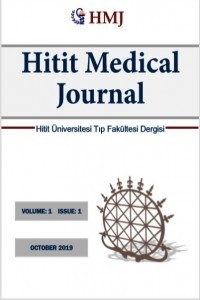İntrahepatik Gebelik Kolestazında Plazma Lipid Düzeylerinin Değerlendirilmesi
Gebeliğin intrahepatik kolestazı, kolesterol, safra asitleri, triglseridler
Evaluation of Plasma Lipid Levels in Intrahepatic Cholestasis of Pregnancy
___
- Girling J, Knight CL, Chappell L, Gynaecologists RCoOa. Intrahepatic cholestasis of pregnancy: Green-top Guideline No. 43 June 2022. BJOG. 2022;129(13):e95-e114.
- Yamamoto Y, Moore R, Hess HA, Guo GL, Gonzalez FJ, Korach KS, et al. Estrogen receptor alpha mediates 17alpha-ethynylestradiol causing hepatotoxicity. J Biol Chem 2006;281(24):16625-16631.
- Rathi U, Bapat M, Rathi P, Abraham P. Effect of liver disease on maternal and fetal outcome--a prospective study. Indian J Gastroenterol. 2007;26(2):59-63.
- Reyes H, Simon FR. Intrahepatic cholestasis of pregnancy: an estrogen-related disease. Semin Liver Dis 1993;13(3):289-301.
- Dalén E, Westerholm B. Occurrence of hepatic impairment in women jaundiced by oral contraceptives and in their mothers and sisters. Acta Med Scand 1974;195(6):459-463.
- Johnson P. Studies in cholestasis of pregnancy with special reference to lipids and lipoproteins. Acta Obstet Gynecol Scand Suppl 1973;27:1-80.
- Reyes H. The spectrum of liver and gastrointestinal disease seen in cholestasis of pregnancy. Gastroenterol Clin North Am. 1992;21(4):905-21.
- Nikkilä K, Riikonen S, Lindfors M, Miettinen TA. Serum squalene and noncholesterol sterols before and after delivery in normal and cholestatic pregnancy. J Lipid Res 1996;37(12):2687-2695.
- Wojcicka J, Sienko J, Smolarczyk R, Romejko E, Grymowicz M, Czajkowski K. Alpha-hydroxybutyrate dehydrogenase activity in intrahepatic cholestasis of pregnancy. Int J Gynaecol Obstet 2005;89(3):247-250.
- Schachter D. Fluidity and function of hepatocyte plasma membranes. Hepatology 1984;4(1):140-151.
- Vore M. Estrogen cholestasis. Membranes, metabolites, or receptors? Gastroenterology 1987;93(3):643-649.
- Sepúlveda WH, González C, Cruz MA, Rudolph MI. Vasoconstrictive effect of bile acids on isolated human placental chorionic veins. Eur J Obstet Gynecol Reprod Biol 1991;42(3):211-215.
- Monte MJ, Morales AI, Arevalo M, Alvaro I, Macias RI, Marin JJ. Reversible impairment of neonatal hepatobiliary function by maternal cholestasis. Hepatology. 1996;23(5):1208-1217.
- Johnson P, Samsioe G, Gustafson A. Studies in cholestasis of pregnancy. I. Clinical aspects and liver function tests. Acta Obstet Gynecol Scand 1975;54(1):77-84.
- Dann AT, Kenyon AP, Wierzbicki AS, Seed PT, Shennan AH, Tribe RM. Plasma lipid profiles of women with intrahepatic cholestasis of pregnancy. Obstet Gynecol. 2006;107(1):106-114.
- Svanborg A, Vikrot O. Plasma lipids in recurrent jaundice of pregnancy. Acta Med Scand. 1967;181(1):83-7.
- de Aguiar Vallim TQ, Tarling EJ, Edwards PA. Pleiotropic roles of bile acids in metabolism. Cell Metab 2013;17(5):657-669.
- Fiorucci S, Mencarelli A, Palladino G, Cipriani S. Bile-acid-activated receptors: targeting TGR5 and farnesoid-X-receptor in lipid and glucose disorders. Trends Pharmacol Sci 2009;30(11):570-580.
- Chiang JYL, Ferrell JM. Bile acid receptors FXR and TGR5 signaling in fatty liver diseases and therapy. Am J Physiol Gastrointest Liver Physiol 2020;318(3):G554-G573.
- Keitel V, Dröge C, Häussinger D. Targeting FXR in Cholestasis. Handb Exp Pharmacol 2019;256:299-324.
- Abu-Hayyeh S, Papacleovoulou G, Lövgren-Sandblom A, Tahir M, Oduwole O, Jamaludin NA, et al. Intrahepatic cholestasis of pregnancy levels of sulfated progesterone metabolites inhibit farnesoid X receptor resulting in a cholestatic phenotype. Hepatology 2013;57(2):716-726.
- Zhan Q, Qi X, Weng R, Xi F, Chen Y, Wang Y, et al. Alterations of the Human Gut Microbiota in Intrahepatic Cholestasis of Pregnancy. Front Cell Infect Microbiol. 2021;11:635680.
- National Cholesterol Education Program. Second Report of the Expert Panel on Detection, Evaluation, and Treatment of High Blood Cholesterol in Adults (Adult Treatment Panel II). Circulation 1994;89(3):1333-1445.
- Geenes V, Williamson C. Intrahepatic cholestasis of pregnancy. World J Gastroenterol 2009;15(17):2049-2066.
- Lammert F, Marschall HU, Glantz A, Matern S. Intrahepatic cholestasis of pregnancy: molecular pathogenesis, diagnosis and management. J Hepatol 2000;33(6):1012-1021.
- Ovadia C, Seed PT, Sklavounos A, Geenes V, Di Ilio C, Chambers J, et al. Association of adverse perinatal outcomes of intrahepatic cholestasis of pregnancy with biochemical markers: results of aggregate and individual patient data meta-analyses. Lancet 2019;393(10174):899-909.
- Geenes V, Chappell LC, Seed PT, Steer PJ, Knight M, Williamson C. Association of severe intrahepatic cholestasis of pregnancy with adverse pregnancy outcomes: a prospective population-based case-control study. Hepatology 2014;59(4):1482-1491.
- Blackwell SC, Wolfe HM, Redman ME, Hassan SS, Berry SM, Treadwell MC, et al. Relationship between meconium staining and amniotic fluid volume in term pregnancies. Fetal Diagn Ther 2002;17(2):78-82.
- Yayın Aralığı: Yılda 3 Sayı
- Başlangıç: 2019
- Yayıncı: Hitit Üniversitesi
Türkiye'nin Çorum ilinde yaşam bölgelerine göre tamamlayıcı-alternatif tıp bilgi ve tutumları
Hülya YILMAZ BAŞER, Coşkun ÖZTEKİN
Gülten CAN SEZGİN, Hilal SİPAHİOĞLU, Kürşat GÜNDOĞAN, Ramazan COŞKUN, Şahin TEMEL, Cevat YAZICI, Okhan AKDUR, Murat SUNGUR, Muhammet GÜVEN
Anestezistlerin Pratikte Premedikasyon Uygulamalarının Değerlendirilmesi
Tuğçehan SEZER AKMAN, Hatice SELÇUK KUŞDERCİ, Lokman KEHRİBAR, Bahattin Çağdaş AKMAN, Ahmet ŞEN
Yücel KANAL, Hatice Eftal Şeyda KANAL
İntrahepatik Gebelik Kolestazında Plazma Lipid Düzeylerinin Değerlendirilmesi
Merve ÖZTÜRK AĞAOĞLU, Zahid AĞAOĞLU, Şevki ÇELEN
Aynı Tarafta Sakroileit ve İliak Kemiğin Basit Kisti Birlikteliği: Bir Vaka Sunumu
Zeynep KIRAÇ ÜNAL, Methiye Kübra SEZER, Aynur TURAN, Ajda BAL
Arpa Çiminin Diyabetli Ratlarda Antioksidan Kapasitesine ve DNA Hasarına Etkisi
Arzu COMBA, Leyla MİS, Devrim SARIPINAR AKSU, Yıldıray BASBUGAN, Bahat COMBA
Mehmet ÜNSAL, Uğurcan ZORLU, Gizem AKTEMUR, Nazan VANLI TONYALI, Elif Gülşah DİKTAŞ, Ayse Gulcin BASTEMUR, Sadiman KİYKAC ALTİNBAS, Tuğba ALTUN ENSARİ
